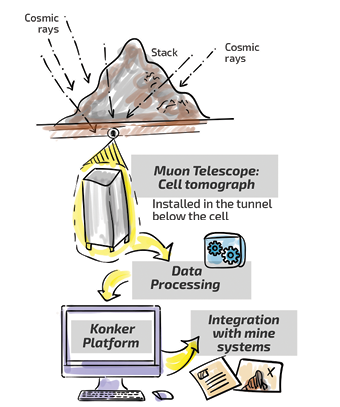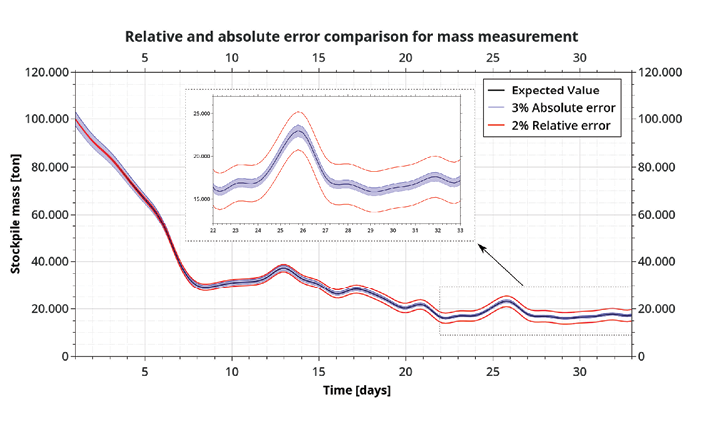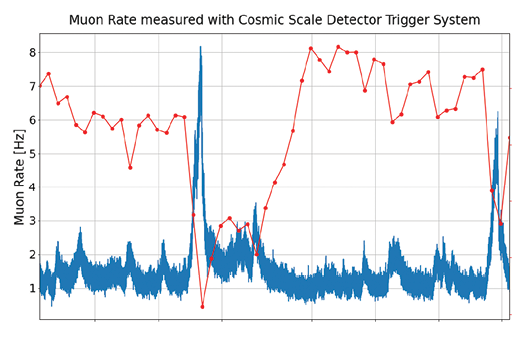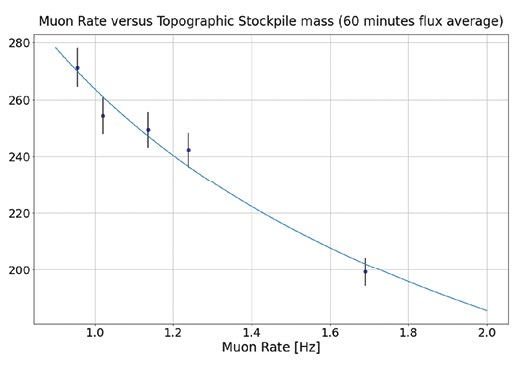The Muon telescope
Measuring density and volume through an innovative solution
that employs cosmic rays

A Muon telescope measures the flow and trajectory of incoming particles derived from muons, one of the secondary cosmic rays’ components, coming from Earth’s upper atmosphere and passing through matter in their way which creates an attenuation. Different matters generate different known attenuations that can be used in a reverse manner to infer the type of material, density, and dimensions of that same matter in the way of the flow.
Because of the regularity in which this muon flow occurs, accordingly varying to solar cycles and atmospheric pressure, and in all directions with a known angular distribution, it is possible to measure the attenuation with a sensor. The telescope captures the previously mentioned measurements of whatever is directly close to it, working similarly to a tomograph for much bigger volumes, and with the advantage of using naturally occurring radiation. This radiation is sustainable, free, and available anywhere on the planet.
The telescope measures the density and volume of any material placed under or next to it, as it detects cosmic muons. By passing through material, the muon flux changes its attributes, that are analyzed by the telescope to detect what it passed through, how dense, and heavy the material is. Konker, the specialist operators of the Muon telescope, backtracks and maps the different densities looking into large amounts of mass comparable to a tomograph to discover security relevant deviations of density in tailings dams and inverted cones in stockpiles amongst other possible applications. As the muon flux is absolute, constant, and naturally available, it is more accurate and sustainable than many conventional solutions. The measurements can be fed into any available supply chain system by using the provided interfaces, thus making it a seamless and fully end-to-end integrated solution.
The solution is autonomous and self-calibrating, making human interaction obsolete, works around the clock, and able withstands extreme climate conditions. For planning and forecast ability, all data collected is stored, allowing for the application of constantly improving prediction models and comparisons of historical data.
The data measurements are processed through analytics and machine learning algorithms, allowing for the generation of extremely accurate measurements which are then mapped and integrated into the value chain and possibly the IT/OT processes of mining companies.
One unique proposition of Konker’s muon telescope is the fact that it is self-calibratable. It requires no human intervention to keep itself working properly for long periods of time. Also, it applies a concept that is broadly used in tests conducted in laboratories, which means it conforms to the industrial standards and environments.
Ore piles
For most companies, the preferred way to store ores is through the formation of conic ore stockpiles in which the minerals are deposited into, but this may cause issues in accurately measuring the volume.

The scale method of measuring volume has a relative error that ranges from 3% to 5% and cannot be conducted regularly, thus potentially causing major misinformation. Moreover, it requires human assistance, making it not fully automated. That misinformation can then financially impact companies by hindering the extraction process and the final production.

CREDIT: KONKER
Konker’s method has a more sustainable and accurate approach, as it has an absolute error of 3% in its automated process and can provide more consistent measures. The conventional method can only measure the mass of what is entering and exiting, not what really is in the stockpile at any given moment, causing the error to be cumulative. This implies an error that can gradually grow larger and eventually be much more than the predicted 5%.

reconstruction. CREDIT: KONKER
In addition, mining companies can opt for using aerial photogrammetry to measure volume and dimensions of stockpiles; however, the disadvantage of that method is the fact that it requires favorable climate conditions and human operation, rendering it not fully automated. Furthermore, the measurement is not carried out on a continuous basis.
Further applicability
To this point, the telescope is only used in the mining sector, because of the specificity of large volumes. However, regarding overall effectiveness, muography has merit and efficacy in different fields, such as volcano imaging, archaeology, rock mass density measurements, cargo scanning, and imaging of nuclear waste and reactors.
The security of tailings dams is a crucial factor to the population, nature, and overall environment. To avoid tailings dams’ failure, Konker is offering two distinct solutions. The first solution is measuring the density of coarse tailing in dams to assure that the density does not surpass a safety-critical threshold. This is being done by using adapted, subaquatic telescopes that are distributed in the dam and submerged into the coarse layer. From down under, the telescope, connected to the surface by wiring, is sending its density measurements to the software that maps the data into integrated dashboards.
The second solution is the use of the telescope outside a dam, measuring its safety by the density within the dam and its surroundings, potentially avoiding catastrophic tailings dam failure by early detection of high-risk density abnormalities that may lead to instability and rupture. The idea is to provide a transportable telescope that can be used for quality approval for many dams.
Technical description
The telescope constantly collects muon rate data and, when plotted against the mass measured by the mechanical balances on the pile feed belts, one can observe a very strong anti-correlation between the muon rate measured by the telescope and the mechanical measurement – even before accurate calibration and proper noise reduction.
The first step in using the telescope data is to calculate the individual detection efficiency of the muon sensitive scintillator bars, that use solid state photomultipliers (SiPM) as light sensors, and their temporal evolution. It is not possible to use directionality data, without knowing the efficiency level, and without its evolution, it is impossible to compare measurements taken at different times. Therefore, Konker developed a calibration system that uses multiple coincidence data to directly calculate the efficiency of various detection planes, making use of the same magnitudes added to a Monte Carlo simulation of the telescope’s geometry to infer the efficiencies of other detection planes. Moreover, these efficiency issues related to electronics (such as SiPM gain) can be treated or mitigated remotely. Knowing the detection efficiency over time, it is possible to construct a calibration curve using the measured muon flux data and the mass obtained by topographical reconstruction.
Comments